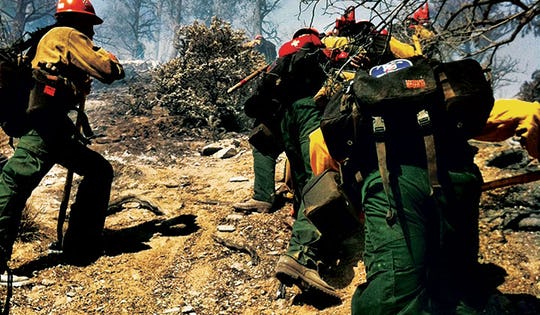In this article I am going to perform strength and conditioning heresy, but after all, isn’t that what the Onnit Academy is all about?
As a rule of thumb, a workout should be structured in a way so that the highly technical work comes first, followed by the power and explosive work, then the strength; the hypertrophy and the endurance/cardio is saved for last. For most people most of the time, following this advice is a damn good idea. It is the safest and very often the most productive style of training for size, strength, and power. Most athletes across the sporting spectrum will follow a format similar to this in a separate session to their technical skills training.
Hostile Work Environments of Hotshot Firefighters
But what if you operate in a different environment? An environment that is hostile, unpredictable and a long way from any assistance? What if your job isn’t to look pretty or to win shiny medals? What if your training doesn’t revolve around a planned schedule of events but requires you to be ready to go at a moment’s notice, never totally sure of what you’ll face when you get there?
If this sounds like you, then the traditional sports science template may not suit your needs. We need to turn the typical standards on their heads and get a little chaotic so that we can thrive in a chaotic environment.
7 Extreme Conditioning Workouts to Survive Hostile Work Environments
We’re going to start by building a base of endurance. This will give us the stamina and mental toughness necessary for work. For pure and simple cardiovascular efficiency, you can’t beat good old fashioned running. Ideally, you’ll run off road covering a variety of terrain, the more varied the better.
Pick a selection of routes, but ensure that none of them are flat! Now lace up your runners and hit the trails three times per week, one long (build up to an hour) and steady, one short and furious, and one intermediate length Fartlek session. Let’s look at these in a little more detail.
Extreme Conditioning Workout #1: The Long Run
This is simply about time on your feet. Speed and distance are secondary to time. Remember that we are looking for cardiovascular efficiency and the ability to keep working for extended periods, and that’s exactly what this run is about. Include a wide variety of terrain; ideally you’ll be running trails in the hills, but an urban park will work if this is unavailable.
Week on week, look to add time until running constantly for an hour becomes comfortable. At this point, consider adding a light backpack or weighted vest. Keep it light and very slowly add weight over time. Every time you pass under something, do a couple of pull ups, jump on and off rocks, duck walk or crawl under low hanging branches, and add in a variety of movements over the route as you get more conditioned.
Extreme Conditioning Workout #2: The Furious Run
If Day 1 is about time on your feet, this one is about moving your feet. Pick a route of varied terrain that is between 1 and 3 miles in length. Now, get around that route as fast as possible; I want you seeing stars at the end of this; I want you blowing out your arse and pumping sweat. Just because the route is short (less than 20 minutes), it should not be easy. Dig deep and power through the urge to slow down.
Once you can run hard for 20 minutes, try adding 2-4 rounds of 5 Pull Ups, 10 Push Ups and 15 Burpees to the end of the run; no resting allowed!
Extreme Conditioning Workout #3: Fartlek Day
This has always been a favorite of mine, so have fun with this. Fartlek is the Swedish word for “speed play” and that’s exactly what we’re going to do. Pick an intermediate distance route, somewhere between the other two, maybe a 45 minute loop but with a variety of terrain.
As you go around the loop, constantly vary your speed. Run at various speeds for various length intervals, leave your gymboss at home, and don’t structure this too much.
The best method to do this is to go out with a friend. As you go around, the two of you will take turns calling out a speed and distance. For example, if you and I are in the woods, I may call “double pace to the top of the rise” and we both pick up the pace up the hill. At the top we return to a jog until you are ready to call out your interval, “race you to the river!” And off we go. Continue in this manner alternating interval selection as you go.
If you perform this session on your own, change your speed each time you recover from a bout. Again, calisthenics or odd lifts can be added to this, either before or after the fast segment. For example, if you find a good rock, press it a dozen times before sprinting off. Maybe you decide to run to the top of a hill and then knock out some jumping jacks at the top. Keep it random and keep it fun.
Structure isn’t necessary, simply add in some extra work to the runs but still cover the distance as quickly as possible. That means run faster! We are developing work capacity and mental toughness, two things you’ll badly need if your working environment turns hostile.
Hotshot Firefighters in the Gym
These are to be gym days. On the first day we focus on strength, the second strength endurance. Both days are to be full body sessions. Again, we will reverse the order that the sports science boffins recommend to us.
Strength Endurance for Hotshot Firefighters
We are going to open with a conditioning circuit, then move onto the heavier strength work. Use a short mobility style warm up before hitting a 20 minute bodyweight/kettlebell/sandbag circuit. Once done, this break out the heavy stuff for the main lifts.
Extreme Conditioning Workout #4: Farmers Work
I took this idea from a Dan John article several years ago. You’ll need a pair of kettebells for this:
1A: Bent Over Row – 6-8
reps x 15meters
1B: Cleans – 6-8
rack walks x 15meters
1C: Squat – 6-8
rack walks x 15meters
1D: Push Press – 6-8
overhead carries x 15meters.
4-6 rounds of this should take approximately 20mins to complete.
Extreme Conditioning Workout #5: Bodyweight/Kettlebell/Sandbag Circuit
Perform the circuit two times through with a 45 to 15 second work to rest ratio on all exercises. This should take 20 mins to complete.
A1: Burpees – 45 sec x 15 sec rest
A2: Swings
– 45 sec x 15 sec rest
A3: Sit Throughs – 45 sec x 15 sec rest
A
4: Cleans (kettles or sandbag) – 45 sec x 15 sec rest
A5: Push Ups – 45 sec x 15 sec rest
A6: “Super Lunges” – 45 sec x 15 sec rest
A
7: Bent Over Row (kettles or sandbag) – 45 sec x 15 sec rest
A
8: Deck Squat – 45 sec x 15 sec rest
A
9: Plank with arm take away
– 45 sec x 15 sec rest
A10: See-Saw press
– 45 sec x 15 sec rest
Strength and Power for Hotshot Firefighters
For the strength and power segment, your choice of equipment is your own. I’d suggest a barbell and a selection of kettlebells or dumbbells. If sandbags, rocks, or logs are your preference, then go for it. As much as I love bodyweight training and respect the massive amount of strength this can build, in this instance we want the feeling of moving an external load.
The lifts we use will be: Power Cleans or High Pulls, Push Presses, Bent Over Rows, Front Squast, and Deadlifts. As we are training under fatigue, be sure that you have a high skill level with each lift. If it is new to you, you should consider substituting or simply training this fresh on another day. For those of a truly unconventional nature, you can use sandbags or rocks, whatever you like as long as it’s good and heavy.
Extreme Conditioning Workout #6: Barbell Basics
A1: Power Clean (or high pull, or overhead throw if only light weight is available.) – 3-5 sets x 3 reps
B1: Deadlift – 4-6 sets x 3 reps
C1: Front Squat – 4-6 sets x 3 reps
D1: Press – 4-6 sets x 3
reps
D2: Bent Over Row – 4-6 sets x 3 reps
Extreme Conditioning Workout #7: Barbell Complex
Perform as a complex, no resting or putting the bar down between exercises. Each round add weight and drop reps, the sets will go: 10, 8, 6, 4, 2,1.
1A: Deadlift
– 6 rounds x 10, 8, 6, 4, 2, 1
1B: Bent Over Row
- 6 rounds x 10, 8, 6, 4, 2, 1
1C: Clean & Press- 6 rounds x 10, 8, 6, 4, 2, 1
1D: Back Squat – 6 rounds x 10, 8, 6, 4, 2, 1
1E: Reverse Lunge
- 6 rounds x 10, 8, 6, 4, 2, 1
This training is not for everyone; it is tough and will break you down over time. I’d suggest ramping up the intensity to a peak over a 4-week period followed by a back week where light duties, jogging, easy circuits, light weights, skills, and drills are the order of the day. Every fourth week should include some kind of PR, be it in a run or on a strength lift. Drop me a line and let me know how you get on, I’d love to hear your feedback.



)





